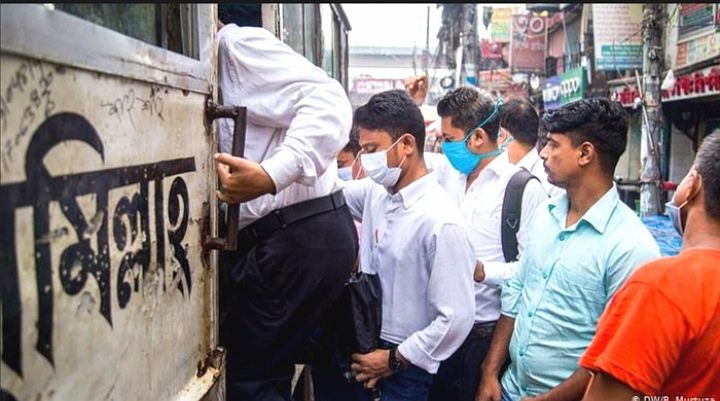Hi everyone! Now I will discuss about covid-19. At the present time, It is running the pandemic situation .But we are floating in the current.



Last Monday, the country was again given a 'lock down', but it did not play any effective role in controlling the corona. Corona infections and mortality are on the rise in the country. At the time of this lock down, at least two pictures and news told us that we have not learned anything from the corona virus of 2020 at all. A photo was probably taken in front of Mugda Hospital in Dhaka. It shows a man lying on the floor, with an oxygen cylinder in his mouth, relatives next to him.
There are no empty seats in the hospital. Probably waiting for a seat. I don't know what happened to that unnamed gentleman. He is not a so-called VIP, so the reporters did not tell his 'follow-up' story. We saw a similar scene in Brazil last year. There are people lying on the streets infected with the coronavirus, and no one was found to bury the dead. Another picture and news was published simultaneously on 7 April. A picture of Chowdhury Mahidul Haque. He was a former executive director of Bangladesh Bank. News headlines - 'ICU not empty: Former bank official dies on the road'.
Mahidul is a freedom fighter. We studied together at Dhaka University. Our friend When he had difficulty breathing at night, his relatives rushed him from one hospital to another for oxygen support. Our Mahidul died without treatment while walking on the streets. Mahidul was one of the top bankers in the country. VIP in the conventional sense. A VIP did not get a 'seat' in the hospital, did not get the necessary oxygen! What could be more tragic than this? This two news are just two of the many news. A new type of corona virus has hit Bangladesh like any other country in the world. The death toll in the country has risen sharply. The death toll on April 9 was 63, with 8482 people identified. So far 9564 people have died.
The government announced a shutdown of public transport in the capital and city corporations, but it was withdrawn on Wednesday. The government's announcement of a 'lockdown' was logical. Health experts have long argued that ‘lockdown’ and ‘social distance’ should be taken into account. But unfortunate but true, no one in Bangladesh wants to accept it. Even after so many deaths, people's awareness has not increased. People do not want to follow any instructions. Crowded ferries seem to be the norm.
The SARS-COV-2 virus is behind Covid-19. If the body has a strong immune system, it will develop as a defense against the virus. So if the body's immune system is strong, the mortality rate will be reduced. Second, the issue of ‘social distance’ must be strictly adhered to in order to reduce infection. According to Joseph Wu, a researcher at the University of Hong Kong, the future will depend on how much social mixing resumes, and what kind of prevention we do.
Joseph Wu is one of the few people who works with epidemics and 'models'. He has tried to show through the model how long the Covid-19 will last. However, new strains of corona virus will come to the world and by 2025 it will put the world at risk. China, New Zealand and Rwanda have been able to contain the virus. This is because of the fact that the lock down is strict so that the virus does not become infected. At the same time, they are strictly adhering to the issue of 'social distance'. As a result, they have been able to bring the mortality rate down to zero (Nature).
This is the real thing. The picture was different in Brazil and the United States. The issue of ‘lockdown’ and social distance was not taken seriously there. April 6 (2021) Four thousand people die in a single day in Brazil. ‘Social distance’ and ‘staying at home’ are repeatedly mentioned by the World Health Organization. Hakan Yilmazkuday, a professor of economics at Florida International University, in a study (Stay-at-Home Works to Fight Against Covid-19: International Evidence from Google Mobility Data) showed (with data from 130 countries), low mobility of ordinary people (grocery shops, parks). , Corona virus infection has been reduced by not going to work or out). The World Health Organization's advice is much the same - stay at home, work from home, do not come in contact with more people.
The reason for the high number of deaths in New York (applicable to Bengalis) was the same - there are a lot of people living there and there is more 'mobility' among the people. What is the explanation of Bangladesh? Last year, thousands of people were brought to Dhaka for the first time under the pretext of 'order cancellation' by the garment industry owners, and the situation worsened when the garment industry was reopened for the second time, crowded ferries and non-surveillance of returnees in January-February. Probably Bangladesh went towards 'hard immunity'! In other words, Bangladesh has done some experiments on whether it is possible to develop immunity naturally among the majority of the population.
It has been successful for the first time. However, there is no reason to think that all countries have gone to 'hard immunity'. Such as Singapore. Singapore rejects Hard Immunity offer Adherence to ‘social distance’ is quite effective for this. So in Medical News Today. In her article (Why social distancing is key in containing the new corona virus, March 24, 2020) Maria Cohut argues for social distance.
Michael Te Vrugt, Jens Bickmann and Raphael Wittkowski have written a scientific paper on the same subject in Nature Communications (Effects or social distancing and isolation on epidemic spreading model via dynamical density functional theory, 4 November 2020). Their commentary - 'Controlling the spread of infections, such as the Plague or the Spanish flu, has been an important topic throughout history'.
They did not lie, history says so - the epidemic comes back again and again. We know about the Spanish flu. The Spanish flu lasted for 36 months, from January 1918 to December 1920. At that time, 500 million people were affected, which was about one third of the world's population at that time. The death toll is estimated at 18 million to 50 million. It is said to have been one of the worst epidemics of modern times. One hundred years ago, during the Ottoman Empire, in the period 1612-1819, 3 lakh people died of plague. We also know of the Asian flu in the middle of the twentieth century, in 1958-1958, when the global pandemic influenza (H2N2) killed 1 to 4 million people. We also know about another type of influenza (H1N1) in 2009-2010, Which spread like a plague all over the world and killed over 5 lakh people. This means that such viruses return to nature again and again.
But this time the outbreak of corona virus is exceptional, spreading to every region of the world. For this reason, we need to consider a few things. One. The World Health Organization says the corona virus will not be completely eradicated (Al Jazeera); This means that even if the virus is temporarily under control, it will remain and return. As Uhane (China) came back again. Two. According to Bloomberg researchers, the next corona virus crisis will be caused by mass suicide (The Next Covid Crisis could be a wave of suicides, May 8, 2020). People will lose their mental balance and commit suicide, which Bloomberg calls ‘death of despair’. Three. Corona virus could cause starvation of 260 million people worldwide (PBS News, April 22, 2020).
This was stated by David Bisle, Executive Director of the World Food Program. So there is no reason to think that the crisis that started with the outbreak of corona virus will end soon. Bangladesh needs to make long-term preparations. I am not sure how much preparation Bangladesh has been able to take. When the second and third waves of the corona virus hit Europe, I can't swear how conscious those involved with our health management were. One specialized hospital should have been established in each departmental town in the last one year. We couldn't do that. Due to this the pressure on the hospitals in Dhaka is increasing. Every hospital should have increased the number of ICU beds and built skilled manpower. That doesn't seem to have happened.
We need doctors, skilled nurses and technicians for specialized diseases. Hospitals need to increase 'lab facilities'. It was necessary to bring in specialists from abroad for training of doctors, we did not do that. China said it would help us with training. There does not seem to be much progress in this regard. We did not take the matter seriously. More hospitals are needed in Dhaka. There is a huge area in Uttara. A medical university like BSMMU can be established here. A specialized hospital can also be established in the abandoned jail area of old Dhaka. In fact, it is necessary to think about the issues.
Another point is that coronary patients should be treated in every hospital without specifying certain hospitals to deal with Covid-19. A typical patient would lie on the veranda of the emergency department or on the street for lack of an ICU bed, a top bank official would die on the way from hospital to hospital for treatment, oxygen, we certainly did not expect that in 50 years of independence. Corona's 'Second Wave' taught us a lot. I don't know how much we will learn from this.